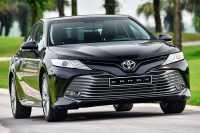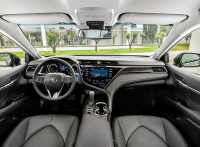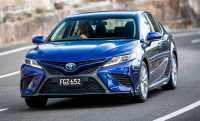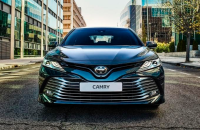Toyota Camry sedan 2019 model year, belonging to the new generation XV70, is available to buyers since the beginning of April 2018. The car differs from the previous generation with an elegant body design and increased rigidity of the suspension. Models with the old engines and a 6-speed automatic transmission partially remain on the market.
Toyota Camry 2019 exterior
The exterior of the car echoes the technology of Lexus (a subsidiary of Toyota). The front has a massive plastic bumper with a central air intake with glossy plastic grille. The narrow headlights helped to reduce the height of the hood, and the lid is equipped with raised ribs of rigidity.
The front has a massive plastic bumper with a central air intake with glossy plastic grille. The narrow headlights helped to reduce the height of the hood, and the lid is equipped with raised ribs of rigidity.
Wheel arches were widened to allow the installation of 18″ and larger wheels. Rear lamps are divided into two sections. There are models with incandescent bulbs (basic version) and LEDs.
New body
The car is equipped with a four-door sedan type body (station wagon is excluded from the Camry production program since the XV30 generation). The design uses elements of high-strength steels and introduces programmable deformation zones, which increased the level of protection of the driver and passengers in collisions. Car interior
Car interior
The interior is equipped with a dashboard made of soft plastic, which reduces the noise level. The touch screen recorder is integrated into the central part of the panel. The designers added decorative trim panels imitating wood or polished metal. The chairs and door cards are trimmed with durable dark-colored fabric or faux black or beige leather. Driver's seat
Driver's seat
The driver's seat is equipped with controls with a mechanical or electric drive, to adjust the lumbar support used pneumatic cushion. Controls are located at arm's length, the instrument cluster got information display with a diagonal up to 7″. Driver and front passenger seats are separated by a massive central console with armrest and cup holders.
Passenger and cargo seating
The increased wheelbase has allowed additional legroom for passengers on the rear row of seats. Some vehicles feature a rear sofa with electrically adjustable backrest angle. The luggage compartment received a flat, removable floor, but the hinged lid somewhat reduced the usable volume.
Technical Specifications
The Camry XV70 is based on the global modular TNGA platform, which has allowed the Japanese concern to reduce the time and cost of developing new models. The power unit is mounted transversely under the hood, and in a frontal impact the engine and gearbox go down, reducing the risk of deformation of the engine shield and reducing the leg room for the driver and passenger. Rack-and-pinion steering with progressive-action electric power steering.
Dimensions
Vehicle dimensions:
length - 4885 mm;
Width (with mirrors removed) - 1840 mm;
height - 1455 mm;
wheelbase - 2825 mm;
ground clearance - 150 mm.
Volume and weight
Weight characteristics of the car (depending on the type of engine):
curb weight - from 1570 to 1700 kg;
allowable gross weight - from 2030 to 2100 kg;
Volume of the luggage compartment (depending on the design of the rear sofa) - 469 or 493 liters.
Engine
The vehicles are equipped with liquid-cooled, variable valve timing engines:
2.0- and 2.5-liter inline four-cylinder engines with 150 and 181 hp;
V-type 6-cylinder, 249 hp at 3.5 liters.
Transmission
The cars have 2 varieties of hydromechanical transmissions with torque transmission to the front wheels:
6-speed with manual shift support (with 2.0 and 2.5L engines);
8-speed, designed for the V-engine.
Suspension, brakes and wheels
The front wheels are mounted on McPherson struts with coil springs and anti-roll bar. At the rear, a wishbone design with shock absorbers and springs and stabilizer is used. Suspensions are fixed on separate subframes, which allowed to improve steerability. Brakes are disc type (ventilated in front), equipped with floating calipers and 2-circuit hydraulic actuator. Alloy wheels with the original design and diameter of 16 to 18 inches are installed by default.
Performance parameters
Factory declared performance characteristics:
maximum speed - 210-220 km/h;
acceleration from a place up to 100 km/h - from 7.7 to 11 seconds;
Fuel consumption in the mixed cycle - from 7.1 to 8.7 liters per 100 kilometers;
fuel consumption in city mode - from 9.7 to 12.5 liters per 100 kilometers of run
fuel tank capacity - 60 liters.
Safety systems
The safety systems include:
inertial seat belts for the driver and passengers (height adjustment was provided in the front);
6 airbags (some models have a knee airbag and additional protective elements in the backrest of the rear row of seats);
ABS system in the brake drive with support of emergency deceleration booster, directional stability system and hill start assistant;
optional Toyota Safety Sense package (on some modifications);
ERA-GLONASS emergency communication system;
headrests of front seats, protecting against fractures of cervical vertebrae and the base of the skull.
Advantages and disadvantages
The advantages of cars, noted by the owners:
good standard noise isolation;
improved visibility from the driver's seat;
roomy trunk.
Disadvantages:
low quality of paintwork and galvanizing;
high fuel consumption in the city stream;
low ground clearance.




